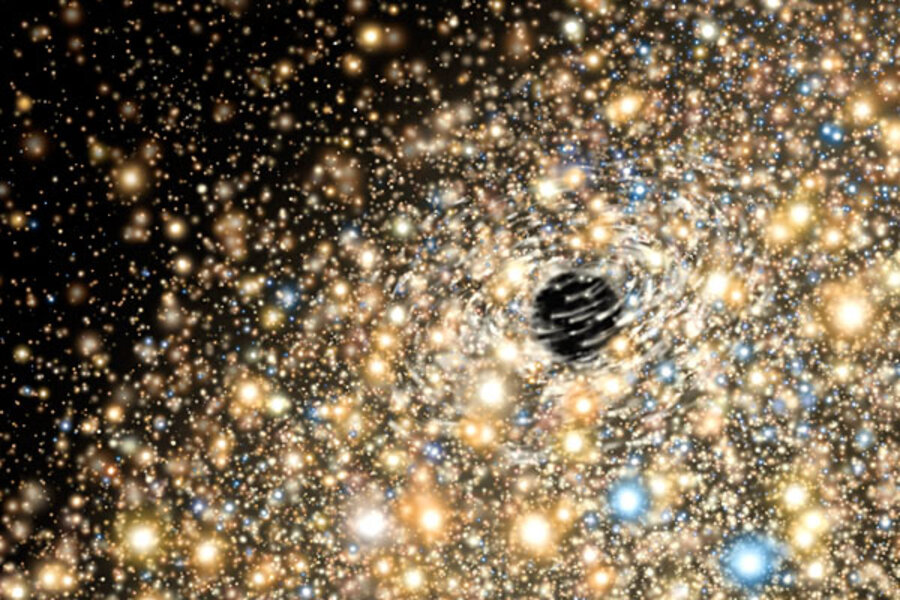Discovery of biggest black holes ever may shed light on galaxy formation
Loading...
Astronomers have discovered evidence for the most massive black holes yet identified, an observation that could help write the history of galaxy formation and evolution over the universe's 13.7 billion-year history.
Black holes are objects whose gravity is so strong even light can't escape. Individual stars can collapse into black holes at the end of their lives. And supermassive descendent black holes lurk in the centers of most galaxies.
Each of these newly discovered black holes sits at the center of a galaxy. Each tips the scales at about 10 billion times the sun's mass, roughly 3 billion solar masses more than the previous record-holder.
One supermassive black hole lurks within a giant elliptical galaxy tagged as NGC 3842, located 320 million light-years from Earth in a cluster of galaxies in the constellation Leo. The other calls NGC 4889 home – another giant elliptical galaxy, 336 million light-years away in a cluster of galaxies in the constellation Coma Berenices.
The Milky Way hosts a much smaller version of these monsters. It tips the scales at roughly 4 million solar masses. If placed at the center of the solar system, its event horizon – the point of no return for matter falling into it – would reach the orbit of Mercury. The event horizons for these new-found behemoths would occupy a patch of space stretching five times father than Pluto's orbit, with their gravity influencing objects some 4,000 light-years away.
Where the Milky Way's supermassive black hole would fit inside the orbit of Mercury, each of these newly detected behemoths encompasses a patch of space five times larger than the orbit of Pluto, their gravity influencing objects up to another 4,000 light-years beyond.
"Black holes play some sort of role in shaping how their galaxies turn out," says Nicholas McConnell, a student en route to a PhD at the University of California at Berkeley and the lead author of the formal paper reporting the results in the Dec. 8 issue of the journal Nature. But that role remains murky.
Knowing how hefty supermassive black holes can get and the types of galaxies they inhabit "will help us, hopefully, figure out how black holes shape their galaxies," Mr. McConnell said in an interview.
Using two large ground-based telescopes in Hawaii and the Hubble Space Telescope, the team of US and Canadian astronomers identified the black holes and estimated their masses based on measurements of the brightness of the galaxies' central bulges and on the orbital velocities of stars in the black hole's neighborhood.
Those velocities slow with distance, ranging from 729,000 miles an hour in the regions they could observe closest to the black hole, to between 604,000 and 671,000 miles per hour some 1,000 to 2,000 light-years out.
These large supermassive black holes may well be the long-dormant engines of what once were quasars. These "quasi-stellar objects" show up as brilliant beacons shining from the distant, early universe. In terms of age, they date to a period when the universe was less then 6 billion to 7 billion years old.
Quasars are young galaxies hosting supermassive black holes that were feeding at a prodigious rate. As they fed, matter approached the black hole's event horizon. The black hole's gravity compressed and heated the dust and gas it was about to gobble. This caused the doomed material to emit enormous amounts of radiation in a kind of cosmic farewell.
Astronomers have cataloged hundreds of quasars, implying that they were common enough that some galaxies in the local universe should host now-quiescent black holes large enough to have energized the most powerful quasars. But none of these black holes have been found, until now.
The black holes the team detected "may be the missing link between quasars and the supermassive black holes we see today," said Chung-Pei Ma, an astrophysicist at UC Berkeley and another member of the team, in a prepared statement.
The black holes already may be providing hints about the formation of their host galaxies, according to Michelle Cappellari, an astrophysicist at Oxford University in Britain.
Writing in the same issue of Nature, she notes that if one uses the variation in stars' orbital velocities alone to estimate the black holes' masses, the answer is smaller than McConnell and colleagues estimate.
She suggests that this signals a merger between each of the two disparate galaxies and smaller galaxies with their own central black holes.





